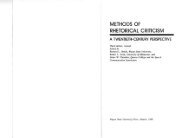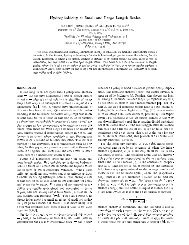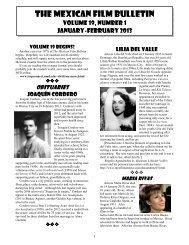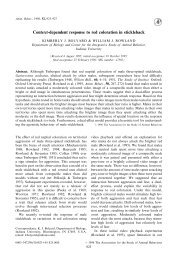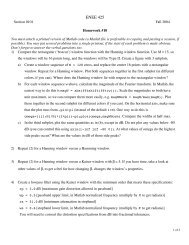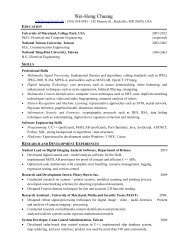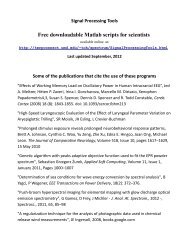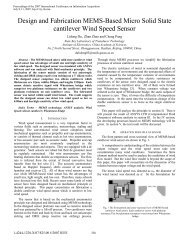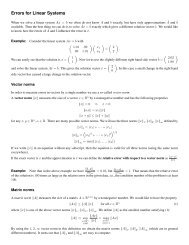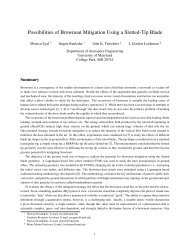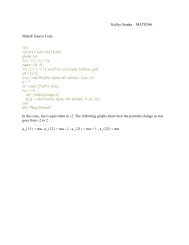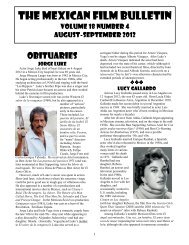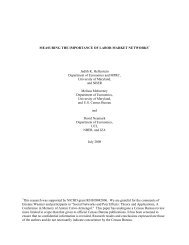Siegecraft - TerpConnect - University of Maryland
Siegecraft - TerpConnect - University of Maryland
Siegecraft - TerpConnect - University of Maryland
Create successful ePaper yourself
Turn your PDF publications into a flip-book with our unique Google optimized e-Paper software.
Introduction<br />
and evinces a clear preference for the sensible realities (prãgmata).<br />
In the Geodesia (6:29, 37) the Anon. Byz. describes geometrical figures<br />
as existing “in concept and reality . . . in reality and imagination”<br />
(noÆsei te ka‹ afisyÆsei . . . afisyÆsei te ka‹ fantas¤&), ref lecting again<br />
dual levels <strong>of</strong> reality, here most similar to those found especially in<br />
Proclus. 31 A number <strong>of</strong> the geometrical figures in Vat. gr. 1605 are notable<br />
in their realistic qualities, for example, a circle depicted with rocks<br />
and bushes on its perimeter (chap. 7), a human figure with a rope measuring<br />
a circle (chap. 7), and a cistern depicted with individual bricks<br />
visible and filled with water to illustrate calculation <strong>of</strong> the volume <strong>of</strong> a<br />
rectangular solid (chap. 9). 32 Finally, the Anon. Byz.’s stated purpose for<br />
his modified verbal descriptions in the introductory passage <strong>of</strong> the<br />
Geodesia (1:28–30)exemplifies as well his approach to illustration: “to<br />
bring down to a low and more sensible level the height <strong>of</strong> their theory<br />
concerning these concepts” (ka‹ tÚ ÍchlÚn t∞w per‹ tå noÆmata yevr¤aw<br />
§p‹ tÚ tapeinÚn ka‹ afisyhtik≈teron katenegke›n). 33<br />
(94 n. 61, as above in note 29) that for convenience <strong>of</strong> argument the Neoplatonists<br />
“sometimes speak simply <strong>of</strong> two levels: sensible (immanent) Forms and psychic Forms<br />
(concepts).”<br />
31 See esp. Proclus, In primum Euclidis librum commentarius 51:14–21 and G. Morrow,<br />
Proclus, A Commentary on the First Book <strong>of</strong> Euclid’s Elements (Princeton, N. J., 1970)<br />
41 n. 5 on the idea <strong>of</strong> fantas¤a as a form <strong>of</strong> nÒhsiw. See also the interesting passage in<br />
Syrianus (In Metaphysica commentaria 6:98:26ff (on 1078a14) on the place <strong>of</strong> fantas¤a<br />
in practical construction: ımo¤vw ka‹ ı mhxanikÚw tØn Ïlhn sxhmat¤zvn §panãgei pçsan<br />
•autoË tØn po¤hsin §p‹ tå êula sxÆmata ka‹ §n fantas¤& m¢n diastat«w, §n diano¤& d¢<br />
émer«w tØn ÍpÒstasin xonta. G. Watson, Phantasia in Classical Thought (Galway, 1988),<br />
119 comments on this passage: “When someone is making something, for instance, he<br />
shapes his matter in accordance with an immaterial blueprint (schemata), which exists<br />
unextended in the mind and in extended fashion in phantasia.” The Anon. Byz., I<br />
suggest, is arguing for the educational value <strong>of</strong> descending still one level <strong>of</strong> reality<br />
further down.<br />
32 One other passage provides evidence <strong>of</strong> the author’s interest in the effect <strong>of</strong><br />
realistic representation. In a recommendation in the Parangelmata (52:5–10) not found<br />
in his classical sources he suggests for the doors <strong>of</strong> a sambuca (a tubelike troop carrier):<br />
Afl d¢ toË aÈtoË stom¤ou yÊrai jvyen kataplhktika‹ diå gluf∞w §kfanoËw ka‹<br />
poluxr≈mou graf∞w sÁn t“ §mprosy¤ƒ m°rei toË aÈloË gin°syvsan, drãkontow µ l°ontow<br />
pur<strong>of</strong>Òron §piferÒmenai protomØn efiw katãplhjin ka‹ fÒbon t«n §nant¤vn proserxom°nhn.<br />
33 It is worth noting that even the traditional geometrical drawings found in the<br />
Geodesia (used to show measurement <strong>of</strong> the height <strong>of</strong> a wall, distances between points<br />
in the horizontal plain, and so on) are given a concrete quality by examples in the text<br />
[ 13 ]



